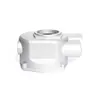Mobile:+86-311-808-126-83
Email:info@ydcastings.com
engine chamber
The Engine Chamber Where Power Meets Precision
The engine chamber is a critical component of any internal combustion engine, serving as the heart of the machine where energy conversion occurs. This concealed space is where fuel and air mix, burn, and generate the power that ultimately drives the vehicle. Understanding the engine chamber's design, function, and significance offers insight into the advanced technology behind modern engines and their role in transportation and industry.
At its core, the engine chamber, often referred to as the combustion chamber, is designed to create an optimal environment for the combustion of air and fuel. The efficiency of this process greatly influences the engine's overall performance, including its power output, fuel efficiency, and emissions. The shape of the combustion chamber—whether it be hemispherical, wedge-shaped, or other designs—affects how the air-fuel mixture is swirled and compressed, thus impacting the effectiveness of combustion.
One key aspect of the engine chamber is the compression ratio, which is defined as the ratio between the maximum and minimum volume of the chamber. Higher compression ratios generally lead to more efficient fuel combustion, which translates into better thermal efficiency and power generation. However, higher compression also raises the risk of knocking, a condition caused by premature ignition of the fuel mixture. This necessitates a delicate balance between compression and combustion timing, highlighting the engineering challenges faced when designing modern engines.
Materials used in the construction of the engine chamber are crucial, as they must withstand extreme temperatures and pressures
. Typically, chambers are constructed using durable materials such as cast iron and aluminum alloys, providing a balance between weight, strength, and thermal conductivity. Advanced manufacturing techniques, such as die-casting and CNC machining, ensure that chambers are crafted with precision, enabling optimized performance and longevity.engine chamber

Moreover, innovations in engine design have introduced technologies like turbocharging and direct fuel injection, which further enhance the efficiency of the engine chamber. Turbocharging utilizes the engine’s exhaust gases to spin a turbine, which forces more air into the combustion chamber, allowing for a greater fuel-air mixture and increased power without significantly increasing engine size. Direct fuel injection operates by injecting fuel directly into the combustion chamber, offering more precise control over fuel delivery, enhancing combustion efficiency, and reducing emissions.
The advent of alternative fuels and hybrid technologies has also had a profound impact on engine chamber design. Electric vehicles (EVs) and hydrogen fuel cells differ fundamentally in energy conversion processes compared to traditional internal combustion engines. However, for hybrid systems that incorporate both electric motors and conventional engines, the engine chamber remains crucial for optimizing the internal combustion engine's contribution to overall vehicle performance. This dual approach requires that engineers refine the engine chamber to support both fuels efficiently, paving the way for sustainable automotive technologies.
In summary, the engine chamber is not just a component; it is a sophisticated technological element that embodies the principles of mechanical engineering and thermodynamics. From its shape and size to the materials used in its construction, each aspect is carefully considered to maximize efficiency and performance. As the automotive industry advances toward greener technologies, the evolution of the engine chamber will play a vital role in meeting regulatory requirements for emissions and enhancing fuel economy. Understanding this component's intricacies reveals the complexity and artistry of engine design, underscoring its importance in the broader context of engineering and innovation.
The future of the engine chamber is undoubtedly intertwined with the ongoing transformation of transportation methods. Whether through improved combustion techniques or the integration of alternative energy sources, the engine chamber will continue to be a focal point for engineers and designers aiming to push the boundaries of what is possible, ensuring that the drive for efficiency and sustainability remains at the forefront of automotive advancement.
-
Unleash Wholesale with YD's Steel Investment CastingNewsAug.04,2025
-
Revolutionize Your Inventory with High-Quality Impeller SolutionsNewsAug.04,2025
-
Power Your Wholesale Business with Premium Electric Power AccessoriesNewsAug.04,2025
-
Elevate Your Wholesale Business with Premium Valve SolutionsNewsAug.04,2025
-
Elevate Your Wholesale Business with Premier Metal Castings SolutionsNewsAug.04,2025
-
Drive Your Wholesale Success with Premium Auto Water Pump SolutionNewsAug.04,2025











